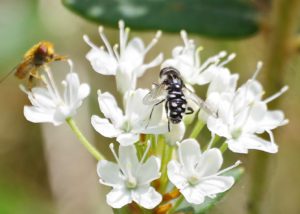Howdy, BugFans,
The BugLady was poking around in a wetland toward the end of May when the Black Chokeberry (Aronia melanocarpa) was in bloom. As she photographed its flower, a syrphid fly or two buzzed in. Any flower shot is enhanced by having an insect in it, right?
Syrphid/Flower/Hover flies (family Syrphidae) are the often-tiny, usually-black-and-yellow bee mimics that perch lightly on or hover above flowers. Some wear patterns that are amazingly etched (an “up-side” of photography is that instead of a fleeting glance, the BugLady gets to put their pictures on the screen and enjoy the intricate tracery https://bugguide.net/node/view/2023052/bgimage, https://bugguide.net/node/view/1611313/bgpage, https://bugguide.net/node/view/1960381/bgimage). Although they are designed to look like bees, they are harmless, and they’re important pollinators.

The BugLady got pretty excited when she put the picture up on the monitor – she had never seen a black syrphid fly with white spots before. When she revisited the wetland a week later as the chokeberry faded, she couldn’t find the fly again.
Turns out that it was a Black bog fly (Parhelophilus porcus). Parhelophilus is a small (20 species) Holarctic genus (meaning that they’re found around the northern half of the globe) with 10 species in North America. There’s another, fairly similar, black and white Parhelophilus that also occurs in Wisconsin, but the rest of them are yellow and black. Adult Parhelophilus flies are mostly recorded eating the nectar and pollen of asters and other composites, but in most of the few pictures that the BugLady could find of this fly, it was on white flowers in the viburnum and rose families.
Parhelophilus larvae are numbered among the rat-tailed maggots; they live in shallow waters of ponds and slow streams and, typical of the tribe Eristalini, breathe through an extended siphon at the rear of their abdomen as they recycle decaying vegetation with the other end https://bugguide.net/node/view/815670.
Here’s what the BugLady found out about the Black bog fly:
- It is found way north, well into the Arctic. Most of the pictures on bugguide.net were taken in New Brunswick. It’s on the Finnish iNaturalist site, and there were some Russian hits.
- It is a pollinator and recycling agent whose presence indicates a healthy bog.
- The Aquatic Insects of Michigan lists it as being “widespread” in Wisconsin, and while it may be widespread, it is in fact a rare, habitat specialist here.
- The same source says that “the systematics of the family are in flux.”
- The larva of the Black bog fly has not been identified or described, nor have its habits been studied.
- It looks a whole lot like Parhelophilus sibiricus, a syrphid fly that’s restricted to bogs in Siberia, and it could be the same species.
- Writing about it in 1997, researcher F. Christian Thompson tells us that “Most of the known sites for porcus are the typical kettlehole bogs (Bingham Pond, Wilson Mills), but some (Laurel Lake site) are better described as fens bordered by spruce, fir and hemlock ……… Unfortunately, for most collected specimens, no site information is available.”
- The Wisconsin Insect Research Collection contains nine specimens of the Black bog fly, all of which were collected in Door County in 1951 (thanks, BugFan PJ).
That’s it.
Go outside – find cool stuff!
Kate Redmond, The BugLady
Bug of the Week archives:
http://uwm.edu/field-station/category/bug-of-the-week/
